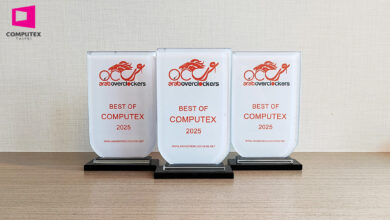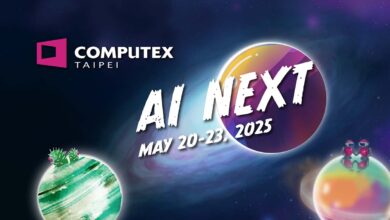When Taipei throws open the doors for COMPUTEX, the industry reads the room. This year it didn’t just read; it recalibrated. From May 20 to 23, 2025, the Nangang halls were stacked wall to wall with silicon, systems, and the unmistakable hum of a market reorganizing itself around artificial intelligence. Organizers framed the show under the banner “AI Next”, and the substance matched the slogan: more than a trade fair, this was a forward control post for the global AI rollout. The official program set the tone AI & robotics, next-gen compute, and future mobility while the scale of the exhibition signaled how broad the shift already is.
What made COMPUTEX 2025 different wasn’t a single blockbuster GPU or a one more hertz monitor; it was the rewiring of the stack from the data center to the device. NVIDIA’s keynote crystallized that shift with NVLink Fusion, a move that opens its high speed interconnect to third party CPUs and accelerators so system builders can stitch together semi-custom AI infrastructure without being locked to one vendor’s full stack. Qualcomm and Fujitsu were named among the first CPU partners, a clear signal that the future AI factory won’t be monolithic it will be modular, heterogeneous, and optimized for real workloads. For operators, this is about throughput per watt and time to deployment; for the ecosystem, it’s about unleashing specialized silicon without giving up the performance and tooling that made NVIDIA’s platform dominant.
That theme AI factories rather than just AI chips played out in the highest stakes announcement of the week. Foxconn and NVIDIA outlined a Taiwan-based “AI factory” aimed at 10,000 Blackwell class GPUs, scaled in phases toward a 100 megawatt footprint, with Kaohsiung as a launch base and expansion potential across multiple Taiwanese cities. Beyond the headline numbers, the strategic value is proximity: compute built next door to TSMC’s wafer output and a dense web of server OEMs shortens supply chains, stabilizes logistics, and compresses time from PO to power on. In a market defined by backlogs and capex cycles, that can tilt advantage toward teams that ship models and services faster.
While racks and interconnects grabbed the enterprise headlines, COMPUTEX 2025 also marked the moment the “AI PC” stopped being a slide and became the default spec. Microsoft’s Copilot+ umbrella accelerated a baseline everyone could understand: laptops equipped with NPUs capable of real local inference, paired with OS level features that actually use it. Vendors leaned in. ASUS filled its booth with Copilot+ designs powered by Snapdragon X series silicon delivering up to around 45 TOPS of NPU performance, the kind of on device muscle that makes audio denoising, image upscaling, transcription, translation and quick-and-dirty generative tasks instant and importantly, offline. Acer’s Computex lineup echoed the push, spanning ultra light productivity machines and creator class notebooks with Copilot+ features baked in. This isn’t a novelty anymore; developers are getting the tool chain, and users are getting battery life plus privacy wins from not shipping everything to a cloud.
The silicon roadmaps under those lids matter, and the show floor brought clarity. Intel demoed early Panther Lake client CPUs built on its 18A process, positioning the architecture as the follow through to Lunar Lake’s efficiency and Arrow Lake’s performance, with public timelines coalescing around a 2026 window. The subtext is familiar: Intel needs a clean landing to stay neck and neck in the AI-PC era, and the company used Taipei to show real boards and running systems rather than just slides. Meanwhile, Qualcomm treated COMPUTEX as a momentum builder for its Snapdragon X series laptops, and AMD’s partners showed machines spanning Ryzen AI 300 through creator and gaming class rigs evidence that the “AI PC” is not a single brand’s story but an industry wide reset of laptop design targets.
Displays were a mood all their own. If last year was about making OLED normal for gamers and creators, this year was about bending physics. Demonstrations and round ups from the show spotlighted 500Hz class 1440p QD-OLED panels, a new wave of glossy options, and the steady march of dual-mode displays that can trade resolution for extreme refresh on command. NVIDIA’s variable refresh tech narrative also persisted through the year with “Pulsar” demos cropping up around major events, underscoring how motion clarity, latency, and HDR handling are becoming as strategic to immersion as raw pixel counts. The practical impact for buyers is simple: the sweet spot for esports grade clarity and creator grade color is moving down in price and up in availability, and the generation seeded at COMPUTEX is the one that will hit retail in meaningful volumes across late 2025 into early 2026.
For ArabOverclockers readers who work at the edge gyms, studios, agencies, clinics the most consequential subplot might have been robotics. While the show’s focus was broader than humanoids, NVIDIA used Taipei to advance its “physical AI” story with new Isaac platform pieces like GR00T N1.5 and GR00T-Dreams for generative motion data, essentially giving developers faster ways to teach robots complex sequences without months of on site data collection. Foxconn, for its part, showcased healthcare focused automation built on NVIDIA stacks from the data center to the ward, connecting the dots between Taiwan’s server might and practical deployments on hospital floors. In the months after COMPUTEX, NVIDIA’s Jetson Thor platform reached general availability, dropping data center-class reasoning into a 130 watt module designed to run multiple generative models on robot an inflection that turns “cloud-tethered demos” into “shippable autonomy”. The through line is hard to miss: Taipei wasn’t just about training bigger models; it was about giving machines the brains and toolchains to act safely and intelligently in the physical world.
Macroeconomically, COMPUTEX 2025 made Taiwan’s leverage in the AI era feel both obvious and newly formalized. ArabOverclockers framed the show as a stage for AI advances and as a lens on geopolitics, tariffs, and supply resilience; by August, follow up reporting highlighted how Foxconn’s growth had already tipped from consumer electronics toward cloud and networking, with AI servers leading the charge. The island’s clustering of wafer capacity, server assembly, networking, and now AI-factory buildouts means the center of gravity for AI hardware remains in a tight radius great for speed, but not without policy scrutiny. For buyers from Cairo to Riyadh, the practical implication is that price and availability of AI PCs, OLED displays, and even hosted Blackwell instances will often trace back to how smoothly this ecosystem scales.
The most honest way to read COMPUTEX 2025 is to stop thinking of AI as a feature and start recognizing it as the platform. In the data center, NVLink Fusion flips the script from closed stacks to cooperatively engineered fabrics that invite specialized silicon into the room without sacrificing performance. On the client side, Copilot+ machines with real NPUs are turning “AI-assisted” workflows into default behaviors that save battery, protect data, and remove friction for creators and professionals. In between, a wave of display tech and edge robotics advances is smoothing the human machine interface, whether that means fewer artifacts on a 500Hz OLED or a hospital robot that can learn and execute novel tasks safely. Taipei didn’t just foreshadow that future it began shipping it.
We’ve covered COMPUTEX for years, but this one felt like a hinge. If you’re planning upgrades, the practical calculus is changing. For workstations and render boxes, watch the semi custom wave and how quickly regional cloud providers light up Blackwell era instances. For laptops, prioritize genuine NPU muscle and thermals that make sense in MENA heat. For displays, keep an eye on the 500Hz 4K 240 class born on the show floor, landing in carts soon. COMPUTEX 2025 wasn’t just an exhibition; it was a deployment plan with Taiwan at the center and AI in every layer of the stack.



